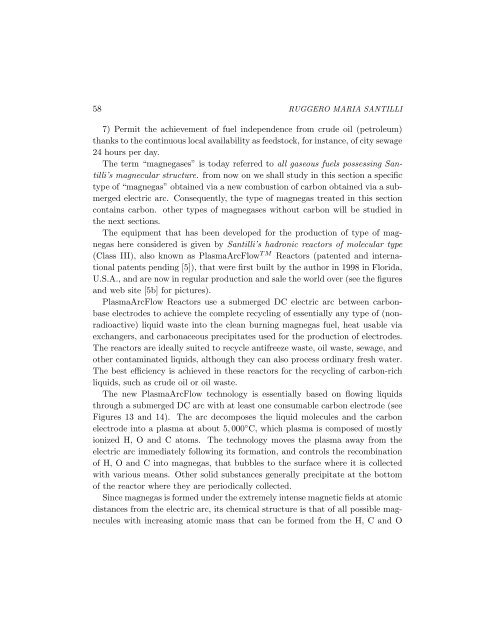the new fuels with magnecular structure - Institute for Basic Research
the new fuels with magnecular structure - Institute for Basic Research
the new fuels with magnecular structure - Institute for Basic Research
You also want an ePaper? Increase the reach of your titles
YUMPU automatically turns print PDFs into web optimized ePapers that Google loves.
58 RUGGERO MARIA SANTILLI<br />
7) Permit <strong>the</strong> achievement of fuel independence from crude oil (petroleum)<br />
thanks to <strong>the</strong> continuous local availability as feedstock, <strong>for</strong> instance, of city sewage<br />
24 hours per day.<br />
The term “magnegases” is today referred to all gaseous <strong>fuels</strong> possessing Santilli’s<br />
<strong>magnecular</strong> <strong>structure</strong>. from now on we shall study in this section a specific<br />
type of “magnegas” obtained via a <strong>new</strong> combustion of carbon obtained via a submerged<br />
electric arc. Consequently, <strong>the</strong> type of magnegas treated in this section<br />
contains carbon. o<strong>the</strong>r types of magnegases <strong>with</strong>out carbon will be studied in<br />
<strong>the</strong> next sections.<br />
The equipment that has been developed <strong>for</strong> <strong>the</strong> production of type of magnegas<br />
here considered is given by Santilli’s hadronic reactors of molecular type<br />
(Class III), also known as PlasmaArcFlow T M Reactors (patented and international<br />
patents pending [5]), that were first built by <strong>the</strong> author in 1998 in Florida,<br />
U.S.A., and are now in regular production and sale <strong>the</strong> world over (see <strong>the</strong> figures<br />
and web site [5b] <strong>for</strong> pictures).<br />
PlasmaArcFlow Reactors use a submerged DC electric arc between carbonbase<br />
electrodes to achieve <strong>the</strong> complete recycling of essentially any type of (nonradioactive)<br />
liquid waste into <strong>the</strong> clean burning magnegas fuel, heat usable via<br />
exchangers, and carbonaceous precipitates used <strong>for</strong> <strong>the</strong> production of electrodes.<br />
The reactors are ideally suited to recycle antifreeze waste, oil waste, sewage, and<br />
o<strong>the</strong>r contaminated liquids, although <strong>the</strong>y can also process ordinary fresh water.<br />
The best efficiency is achieved in <strong>the</strong>se reactors <strong>for</strong> <strong>the</strong> recycling of carbon-rich<br />
liquids, such as crude oil or oil waste.<br />
The <strong>new</strong> PlasmaArcFlow technology is essentially based on flowing liquids<br />
through a submerged DC arc <strong>with</strong> at least one consumable carbon electrode (see<br />
Figures 13 and 14). The arc decomposes <strong>the</strong> liquid molecules and <strong>the</strong> carbon<br />
electrode into a plasma at about 5, 000 ◦ C, which plasma is composed of mostly<br />
ionized H, O and C atoms. The technology moves <strong>the</strong> plasma away from <strong>the</strong><br />
electric arc immediately following its <strong>for</strong>mation, and controls <strong>the</strong> recombination<br />
of H, O and C into magnegas, that bubbles to <strong>the</strong> surface where it is collected<br />
<strong>with</strong> various means. O<strong>the</strong>r solid substances generally precipitate at <strong>the</strong> bottom<br />
of <strong>the</strong> reactor where <strong>the</strong>y are periodically collected.<br />
Since magnegas is <strong>for</strong>med under <strong>the</strong> extremely intense magnetic fields at atomic<br />
distances from <strong>the</strong> electric arc, its chemical <strong>structure</strong> is that of all possible magnecules<br />
<strong>with</strong> increasing atomic mass that can be <strong>for</strong>med from <strong>the</strong> H, C and O














